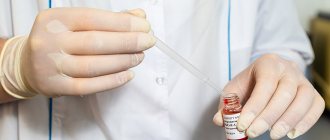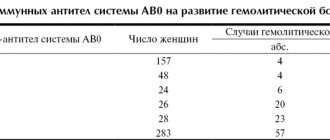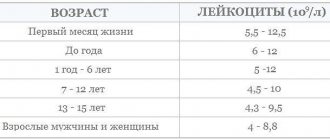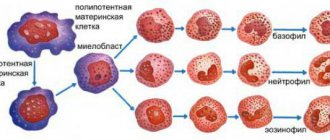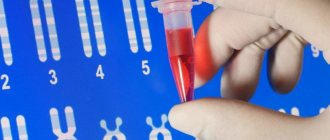Why is it important to know your blood type?
Determining blood group compatibility is necessary, first of all, for transfusion (blood transfusion). Large blood loss is deadly. Since ancient times, attempts have been made to compensate for blood loss by infusing the blood of another person. But the first blood you come across cannot be used. When mixing blood “blindly,” in about half of the cases, agglutination occurs: red blood cells (erythrocytes) begin to stick together, forming clumps. The flakes resulting from agglutination are visible in a test tube with the naked eye; it is clear that if this process happens inside the circulatory system, nothing good can be expected for a person.
Agglutination
At the beginning of the 20th century, it was established why agglutination occurs. On the surface of the erythrocyte (red blood cell) membrane there are special antigen proteins (they are called agglutinogens). They are called antigens because they can bind to other substances - antibodies. This connection is specific, that is, a given antigen can only be bound by a specific antibody. When we talk about blood groups, we use a system that is only interested in two antigens (in fact, there are many more of them “riding” on red blood cells). For convenience, these antigens (agglutinogens) are designated by the first letters of the Latin alphabet - A and B. The corresponding antibodies (they are called agglutinins) are designated by the first letters of the Greek alphabet - α (alpha) and β (beta).
Obviously, an antigen and its corresponding antibody cannot be present in the blood at the same time, otherwise a reaction (agglutination) would occur. But other combinations are possible. They are the ones who determine which group our blood belongs to.
Decoding the results
5 minutes pass and the analysis results can be assessed. In large drops of serum, clearing occurs, in some small flakes are formed (agglutination reaction), in others they are not. Here are the possible options:
- if there is no agglutination in both samples with sera of groups III and II (+ control 1 and 1V) - this is the first group;
- if coagulation is noted in all except II, this indicates the second group;
- in the absence of agglutination only with III serum, the third blood group is established;
- if coagulation is observed in all samples, including the 1V-control - group four.
When the sera are arranged in the correct order, with signatures on the plate, it is easy to navigate: where there is no agglutination, there is a group.
There are times when the bonding is not clearly visible. Then the analysis is redone, fine agglutination is examined under a microscope.
Blood groups and their compatibility
In domestic medicine, groups are designated by a number and called accordingly: first, second, third, fourth. Abroad, this system is called AB0 and the corresponding designations are used.
Group I
(group 0) – first (or zero). People with blood of this group do not have both agglutinogens (A and B) on the erythrocyte membrane, but agglutinins α and β are present in the plasma.
Group II
(A) – second group. The blood of this group contains agglutinogen A and agglutinin β.
Group III
(B) – third group. In the blood, agglutinogen B is present on erythrocytes, and agglutinin α is present in the plasma.
Group IV
(AB) – fourth group. Both antigens are present on red blood cells, but there are no antibodies in plasma.
Whole blood can be transfused only when the blood of both the donor and recipient belongs to the same group. Red blood cells can also be used for transfusion (they are separated from the plasma), in which case only agglutinogens are important. Red blood cells of a person of the first blood group can be transfused to everyone, since they cannot introduce antigen and provoke agglutination. Therefore, a person with the first blood group is a universal donor.
Red blood cells of the second group can be transfused to people who already have agglutinogen A in their blood - that is, with the second and fourth groups. Accordingly, red blood cells of the third group can be transfused to those who have agglutinogen B in their blood; these are the third and fourth groups.
A person with blood type IV is a universal recipient: he can receive red blood cells from people with any blood type, while his blood can only be used for transfusion to people with the same blood type.
Rhesus system
Levine and Stetson discovered Rh antigens in 1939. Scientists studied the reasons for the development of hemolytic reactions in women in labor during transfusions of husbands' erythrocytes identical in the AB0, MN and P systems. A year later, Landsteiner and Wiener produced antibodies by immunizing rabbits with red blood cells from rhesus monkeys. The antibodies are called anti-RH antibodies. The resulting agglutinins entered into an agglutination reaction with the erythrocytes of rhesus monkeys and with the erythrocytes of 85% of New York citizens of the white race. The antigen that caused the formation of antibodies was called RH factor (D factor).
The Rhesus system combines 45 antigens. Agglutinogens are inherited and remain unchanged throughout life. Immunogenicity decreases in the following order: D > c > E > C > e. Each agglutinogen is encoded by one of two closely related genes: RHD is responsible for the production of the D antigen, RHCE is responsible for the production of the Cc and Ee antigens. Rh-positive donors are considered individuals with D, C or E antigens on the surface of red blood cells. In the absence of the above agglutinogens, donors are considered Rh negative.
In rare cases, human red blood cells do not contain any Rh antigen. The phenotype is designated RhNULL. The Xro gene in this case is presented in homozygous form and suppresses the production of all antigens. Holders of the RhNULL phenotype do not exhibit agglutinogenic activity, but have the ability to transmit antigens by inheritance.
Among Europeans, the frequency of Rh D antigen-positive individuals is 85%. There are usually about 10,000 – 30,000 D molecules located on the membrane of red blood cells. There are two special types of D-positive individuals: Du (weak) and Dpartial (partial). The immune system of Du and Dpartial is capable of producing anti-D antibodies.
Weak antigen occurs in 1.5% of Rh-positive individuals and is characterized by a low number (100–500) of D molecules on the membrane. Is immunogenic for Rh-negative individuals. In this case, transfusion of D-positive erythrocytes to patients with weak D may cause sensitization of the donor’s blood cells. Erythrocytes with Du are weakly agglutinated or do not at all enter into a direct agglutination reaction with complete anti-Rh antibodies. Determination of Rh status is carried out using an indirect antiglobulin test. Du carriers are considered Rh-positive donors and Rh-negative recipients.
Partial D is deficient in one or more epitopes of a protein molecule. The immune system of people with Dpartial is capable of producing antibodies to the missing epitopes. Among partial antigen carriers, seven groups of individuals are distinguished. The DVI carriage (only epitope Z is present) has the greatest clinical significance: owners of this category produce antibodies to the unchanged antigen and to partial antigens DI - DV, DVII. The technique for detecting the Rh factor DVI consists in the sequential use of two diagnostic kits: monoclonal IgM anti-D antibodies (coliclone Anti-D-Super or Anti-D IgM) and polyclonal or monoclonal IgG antibodies anti-D (standard universal reagent or coliclone Anti-D D). A negative reaction result in the first and a positive result in the second stage of the study indicates the detection of DVI. Typically, the DVI category corresponds to the CcDee genotype. Pregnant women with DVI who carry a fetus with complete D are prescribed anti-Rhesus immunoglobulin.
Antibodies against Rh antigens are immune. They arise due to isosensitization. Specificity is determined by the antigens that provoke the formation of antibodies. Complete and incomplete antibodies are isolated.
Complete are IgM antibodies. They are distinguished by their large molecular weight and are detected less frequently compared to incomplete antibodies. Capable of agglutinating Rh-positive red blood cells. They are less important during transfusions.
Incomplete ones predominantly belong to the IgG class. They are attached to the surface of Rh-positive erythrocytes without the formation of agglutinates. The gluing of blood cells is carried out in the presence of colloidal solutions and proteolytic enzymes or after treatment with antiglobulin serum. They have a smaller molecular weight compared to full antibodies. Capable of passing through the placenta. During sensitization, complete antibodies are first produced, then incomplete antibodies (IgG immunoglobulins) are produced to a greater extent.
Over 90% of complications during blood transfusions are caused by incompatibility of the donor and recipient with the Rho(D) antigen. The hr'(c) antigen is also of great importance. Agglutinogen is present in 80–82% of the population. The remaining 18–20% of individuals fall into the high-risk group due to the high likelihood of hr'(c) incompatibility with donors and the development of post-transfusion complications.
Technique for identifying the Rh factor using zoliclon Anti-D-Super
Tsoliklon Anti-D-Super is a complete human anti-D IgM antibody. To obtain reliable results, the analyzed sample must contain a sufficient number of red blood cells.
- Provide good lighting and room temperature in the room.
- Place one large drop (approximately 0.1 ml) of Anti-D IgM on the plate.
- Place one small drop (approximately 0.03 ml) of the red blood cells being tested nearby.
- Mix two drops with a sterile stick.
- After 10–15 seconds, gently rock the plate for 20–30 seconds.
- Check for agglutination three minutes after mixing.
If a reaction occurs, the blood is assessed as Rh-positive (Rh+), if there is no reaction - as Rh-negative (Rh-). If agglutination is negative or weak, it is necessary to repeat the test with incomplete anti-D IgG antibodies in order to detect weak or partial D antigen.
reaction result
visual assessment of reaction results in transmitted light
registration of analysis results
Method for determining the Rh factor Du in a tube test
In parallel with the analysis, three control samples are performed: the reagent coliclone Anti-D (anti-D IgG) with standard Rh-positive and Rh-negative erythrocytes, the analyzed erythrocytes with a gelatin solution without the anti-D IgG diagnosticum.
- Place 0.05 - 0.1 ml (one drop) of red blood cells from a clot of coagulated blood or washed from a preservative into a test tube.
- Add 0.1 ml (two drops) of 10% gelatin heated until liquefied at 45 - 50 °C.
- Add one drop of Anti-D Zoliclone (Anti-D IgG).
- Perform mixing.
- Incubate the tube in a water bath for 10–15 minutes or in a thermostat at 48 °C for half an hour.
- Add 5 - 6 ml of isotonic solution.
- Invert the test tube 1 – 2 times.
- Assess for the presence of agglutination in transmitted light.
The absence of reaction results with anti-D IgM and pronounced agglutination with anti-D IgG indicate the detection of weak forms of antigen D. In case of weak agglutination, the test should be repeated in the indirect Coombs test.
When is blood type determination performed?
Indications for determining blood group are:
- the need for blood transfusion;
- preparation for operations. Any operation is a risk; under certain circumstances, it may be necessary to replace blood loss, and then doctors should know what kind of blood can be used for this;
- management of pregnancy. In some cases, there may be incompatibility between the blood groups of mother and child. If there is a blood type conflict, the child may be born with hemolytic disease of the newborn (hemolytic jaundice). To determine the baby's blood type, umbilical cord blood is taken for analysis immediately after birth. But a conflict based on blood type can also be judged during pregnancy – by the level of antibodies in the mother’s blood. The risk of blood type incompatibility between mother and child is calculated based on the likely blood type of the child, which, in turn, depends on what blood type the mother and father have. To assess this risk, it is necessary to take a test to determine your blood type during pregnancy.
Blood group determination
When doctors need to find out the blood type, the analysis is usually done again. This is done to completely eliminate the possibility of errors resulting from the use of incorrect data. The doctor will not ask the patient’s blood type, since he is responsible for his life and must have one hundred percent confidence that the blood type is determined correctly.
But knowing your blood type (and the blood type of your children) is still useful. Firstly, no one can be immune from emergencies. And secondly, there is a certain relationship between blood type and predisposition to various diseases.
Tips for home determination
Similar advice is given by people who “live” on the Internet and collect any information indiscriminately. Sometimes they reinterpret it in their own way.
Indeed, there is a theory of nutrition depending on blood type and attempts have been made to connect personality with it. But this was developed to select the most suitable diet and prevent diseases. Even psychologists have stopped talking about the connection between personality type and blood number.
Moreover, you cannot judge your group by your favorite dishes or inclination towards leadership.
It is better to learn anything at home from full-fledged articles and consultations with specialists. There may be medical documents (outpatient records, hospital records) that contain information about your blood.
At the request of donors and hospital patients, the passport can be stamped with this information.
Similar stripes are used on army uniforms.
How to balance your diet
The diet for blood group 3 is aimed at preventing possible diseases. It takes into account products in terms of benefits and degrees of harm.
People with group No. 3 can practically tolerate any food well, because they are maximally protected. However, there is a certain balance in nutrition, preference for certain types of foods. It can be expressed by dividing possible products into three groups.
Which is definitely useful
Lamb, poultry, and rabbit are recommended; among fish, halibut, salmon, sturgeon, flounder, sardine, cod, and pike are preferred.
Dairy products from skim milk, goat milk, Mozzarella cheese, olive vegetable oil, mayonnaise, mustard. The only nuts offered are walnuts and almonds. Legumes are red. Porridge made from oatmeal, rice, millet. White bread.
Vegetables, fruits: beets, carrots, eggplants, cabbage, parsley, parsnips, bananas, grapes, pineapple, ginger. You can drink green tea.
Allowed temporarily
Meat products from beef, turkey, liver. Fish: carp, herring, squid. Butter, hard cheeses, flaxseed oil. Legumes - green peas. Rye bread. Drinking white or red wine, black tea and coffee is rarely possible.
Vegetables, fruits: potatoes, cucumbers, green onions, garlic, pumpkin, spinach, oranges, watermelon, pears, cherries, currants, figs, raisins, prunes, peaches, apples, lemon.
If you decide to eat according to your blood type, you just have to look at some foods
Not recommended
Eastern recommendations are against chicken, goose, duck, ham, pork, and heart dishes. Perch, crayfish, smoked salmon, shellfish, processed cheese, ice cream, sunflower and corn oil, ketchup, seeds, peanuts, lentils, buckwheat, millet and barley porridge, and baked goods are contraindicated.
Vegetables, fruits: tomatoes, radishes, corn, pomegranate, rhubarb, persimmon. Alkaline mineral waters, strong alcohol.
Compatibility tests when planning pregnancy
It should be noted that the Rh factor does not affect the course of the first pregnancy, but it must be determined in order to protect the woman and give her a chance to give birth to a second and subsequent children.
Therefore, future parents need to find out the compatibility of their Rhesus in advance. To check blood compatibility, both spouses must undergo tests at the planning stage.
Women who are Rh negative and planning a pregnancy with a Rh positive man should have a blood test done to check for antibodies. You can donate blood for antibodies even if you are already pregnant. In the latter case, this should be done as early as possible in order to prevent miscarriage and fetal diseases.
Rh factor and pregnancy
Rh compatibility is one of the mandatory tests that are carried out in the antenatal clinic. If the mother is negative, and the child inherits a positive protein from the father, this means that the protein in the fetal blood will simply be unfamiliar to the mother’s body. What does this lead to? The female body perceives the child's blood as a foreign object, which is why the defenses begin to produce antibodies that will attack the fetal cells.
Rhesus conflict can manifest itself as follows:
- anemia;
- jaundice;
- reticulocytosis;
- erythroblastosis;
- hydrops fetalis and edema syndrome in an infant can be fatal.
Conflict will not arise if both parents are compatible with the Rh factor. Thanks to this, the mother’s body will not perceive the developing fetus as a foreign agent.
Cross reaction method
To clarify the group in case of unexpressed agglutination, the method of double cross-reaction with standard erythrocytes is used. In this case, it is not the serum that is known, as in the simple method, but the erythrocytes. The patient's blood is drawn into a test tube, centrifuged, and the serum is pumped out from above with a pipette for testing.
Standard antisera
2 large drops of serum from the patient are dropped onto a flat white plate. They add standard red blood cells A (II) and B (III) blood groups. Stir gradually and shake the plate.
The result is assessed after 5 minutes:
- if agglutination occurred in both drops, group one;
- if not in any sample, group four;
- if in one of the known red blood cells used, then the group is determined by the presence or absence of coagulation in the drop.
